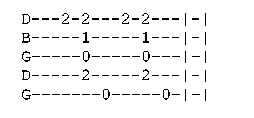Music Education
Learning Banjo - Basic Frailing or Clawhammer
| Share page | Visit Us On FB |
Reading TAB
TAB is a teaching tool. If you look at the snippet of tab above you'll see the five strings of your banjo with the D or first-string on top and fifth or the short string on the bottom.
The numbers on the tab tell you what string to hit and on which fret to- you guessed it- fret the string.
The lines going down through the TAB are used to mark out measures .
A measure is a term used to describe how the rhythm of a song is laid out. The examples in this workshops are all in 4/4 time. 4/4 time is a rhythmic pattern where you are playing four beats to a measure. Without going into a lot of music theory (this is covered extensively in The how and the Tao of Old Time Banjo, and even more extensively in A Book of Five Strings) you can think of 4/4 time as two bump dit-ty strums for each measure.
The example above is the basic strum in open G so all you have is zeros because there isn't any fretting going on. For the same measure in C you'd get this:

Nothing to it, right?
(One thing about the TAB used for this document: I used CSS to set the tab in a mono-spaced font. Without the CSS the TAB might be hard to read. You may want to copy this document and view it in a simple word processing program like Notepad with the font set to Courier-.)
I'm not a huge fan of TAB , but in a text setting it's the only option. I'll stick a few tunes at the end of this, but PLEASE keep in mind that this is a folk style and as such only really works when you play the song as YOU think it should sound, not how it's written down!
Important:
A lot of the nitty gritty details of the stroke change from person to person. Our bodies all work in unique ways. I've got a buddy who adds this freaky little wrist flip after each downstroke. He can play very well so I figure there's no real point in asking him about it. It works for him, what I do works for me.
You can use the index fingernail, and a lot of folks find it easier in the beginning (shoot I've been playing long enough that I can get pretty much the same sound with my pinky) but from what I've seen you can get a cleaner, and in some cases faster, attack with your middle fingernail. Try it for a while.
Another thing to keep in mind is that for the basic explanation of the frailing stroke I told you to keep your index finger straight out. I do this for the simple reason that it helps to keep that finger out of the way when you are just starting out. Once you get used to the motion your index finger will curl or straighten on it's own (it really will) so don't fret about it.
There's also been a lot of debate about bending/not bending the thumb. The stroke described here works- the tip of the thumb playing the fifth technique works for others. Your best bet is to pick one now and stick to it. 99% of the problems most folks have with old time banjo is changing techniques and tunings over and over again.
Pick one, do it until the action becomes almost unconscious and worry about the unimportant stuff when you can play the banjo.